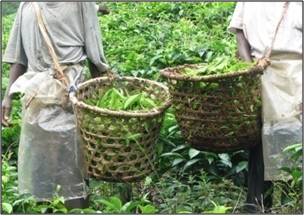|
 Loeseneriella
apocynoides
is a liana that is highly sought after by the communities living
adjacent to Bwindi Impenetrable National Park Uganda. It is used for
weaving baskets, in particular tea baskets, for constructing granaries
and making stretchers. Its slow growth and low rate of regeneration
coupled with this high demand could threaten its survival in the forest.
This study aimed at determining the use of L. apocynoides by
local communities quantitatively, the factors that affect and influence
its distribution and the impact of harvesting on its growth and
distribution. Loeseneriella
apocynoides
is a liana that is highly sought after by the communities living
adjacent to Bwindi Impenetrable National Park Uganda. It is used for
weaving baskets, in particular tea baskets, for constructing granaries
and making stretchers. Its slow growth and low rate of regeneration
coupled with this high demand could threaten its survival in the forest.
This study aimed at determining the use of L. apocynoides by
local communities quantitatively, the factors that affect and influence
its distribution and the impact of harvesting on its growth and
distribution.
The extent
of use was determined through household surveys and interviews with
local weavers, and by assessing the quantity of L. apocynoides
used in weaving different products. The surveys and assessments were
carried out in the parishes of Mpungu, Nteko and Kitojo, communities
within one hour walking distance of the forest boundary. Eight 1
-hectare plots were established in the forest and the plots were
subdivided into 20m by 20m subplots to determine liana abundance in the
forest and monitor the changes in L. apocynoides abundance and
population structure. To assess the impact of demand, plots located at
increasing distances from the park boundary at an interval of 1km. In
each plot, basal diameter of cut stems, height of cut stems, response to
cutting and age of the cut stems were assessed and recorded.
The study
revealed that the use of the species was higher in the lower altitude
areas (especially tea growing areas) of Mpungu compared to higher
altitude areas of Kitojo and Nteko. The most common uses of the liana
were for weaving tea baskets and constructing granaries, these were
mainly observed in Mpungu a major tea growing area. The highest
abundance of stems was also found in Mpungu. The highest stem density
was recorded at an altitude of 1520m to 1640m. The main factor
influencing its local abundance appears to be the availability of
trellis support which is normally Alchornea hirtella. The impact
of harvesting was reflected in the different population structures at
different sites: areas close to the local communities have a higher
proportion of unharvestable stems (either too small or too young), due
to repeated harvesting. Harvestable stems increased in density with
distance from the park boundary.
The study recommends increased use of alternatives for weaving and
granary construction like Flabellaria paniculata, Hippocratea
odogenesis and Smilax anceps. Permanent plots should be
established in a number of sites to monitor the recovery. Communities of
Mpungu showed an interest in growing Arundinaria alpina (bamboo)
on their farms as a substitute for granary making. Bwindi Park
management should consider to allow rhizome harvesting of bamboo by
communities in a controlled manner. |


